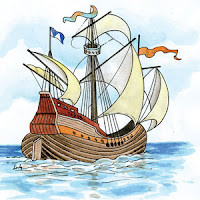Vocabulary
• Abstraction– begins in reality. Seeks the essence of an object. May be expressed
through simplification, stylization, fragmentation, re@assembly, and/or
distortion. Refer to artists such as Hundertvasser, Paul Klee, Beatriz
Milhazes , early Wassily Kandinsky, , Georgia O’Keeffe (abstract works only)
• Non@objective abstraction –Abstraction which does not refer to an object. Refer to
artists!such!as!Jackson!Pollack,!Lee!Krasner,!Joan!Miro,!Alex!Jawlensky,!later
Wassily!Kandinsky,!Sonia!Delaunay,!Robert!Delaunay
• Texture!– refers!to!the!sense!of!touch. Visual texture!looks!like!it!feels!a!certain
way. Actual!texture!really!does!feel!a!certain!way.
• Rhythm!– repetition,!but!not!exact!as!in!pattern,!of!an!object. Helps!move!the!eye
through!an!image.
• Movement!– refers!to!the!path!the!eye!takes!through!an!image. May!be!achieved
through!repetition!of!line,!shape,!color,!texture.
• Unity!– pulls!different!elements!of!a!composition!together. May!be!achieved!with
effective!movement!and!rhythm!in!an!image.
• Organic!line!@@ line forms!an!irregular!shape,!or!one!that!might!be found in!nature,
rather!than!a!regular,!mechanical!shape
• Geometric!Line—line!that!forms!a!straight,!geometric,!or!regular shape
• Color!Scheme—use!of!deliberate!color!relationships!for!mood!and effect.
• Some!Sample!Color!Schemes!Include:
o Complimentary—pairs!of!opposite!colors!on! the!color!wheel:green@red,
blue@orange!and!yellow@purple.!!Complementary!colors!are as contrasting
as!possible!(ie!there!is!no!yellow!at!all!in!the!color!purple).
o Analogous!Colors—Colors!related!on!the!color!wheel!within the same
mixture,!creating!harmony!and value!in!the!color!scheme.
o Tonal! range!@@ the! range! of!tones in!an!artwork! from!light! to! dark.! !A!wide
tonal! range! would! include! all! tones! from! white! to! black.! ! A! narrow! tonal
range!would!include!only!pale!tones,!only!mid!tones!or!only!dark!tones




























